Whales and other marine mammals have been hunted by humans since the beginning of the human civilization. The earliest (4000 years BC) cave paintings of whale hunting were found in Norway. Walruses, seals and whales were fundamental for the nutrition of Arctic indigenous peoples, as food resources in this region are really scarce. Moreover, marine mammals provided materials for building houses, making clothes heating, lighting and treating diseases. The hunting of marine mammals, especially whaling, had become commercial by the 12th century, and since the 18th century it turned into a large-scale industry. With the introduction of new technologies, whaling surged, as well as the demand for products from whales.
Whale oil rendered from blubber was the only fuel for lamps in this period. It was also applied for producing candles, soaps and machinery lubricants. Baleen, or whalebone (horny thin plates that hang from the upper jaw to strain plankton from seawater), was also in high demand at the time for making corsets and hoop skirts. Spermaceti (sperm oil) was used in manufacturing drugs while ambergris was and still is a very good fixative for fine perfumes in the perfume industry.
It is considered that if fuel from petroleum had not been invented in the 19th century, whales would have been exterminated back then. At that time people believed that whales and seals were countless and the marine mammal resources were inexhaustible. One of the well-known examples of human ignorance and greed is the story of the Steller’s sea cow Hydrodamalis gigas. It was discovered on the Commander Islands in 1741 and disappeared off the face of the earth just 27 years later.
After more than 200 years of rapacious extermination, a moratorium on commercial whale hunting was implemented by the International Whaling Commission in 1986. This historical decision also attracted international attention to the other marine mammals. A number of species of dolphins, seals, walruses and sea otters were listed as “vulnerable” to “critically endangered” in the IUCN Red List. On February 19 many countries globally celebrate World Whale Day, also called World Marine Mammal Day. Russia has started celebrating this day since 2002.
Though the hunting has stopped, many other threats still impact the size and welfare of marine mammal populations. Most of these threats are caused by human activities: pollution of the ocean with solid waste, including plastic, oil spills, building of sea ports, oil and gas extraction from shelf zones, etc. Furthermore, many marine mammals are killed by poachers, die in collisions with vessels or get entangled in fishing gear.
Environmental activists and animal rights advocates all over the world have been striving to ban the catch of all marine mammals for a long time. It is prohibited to take all small cetaceans for commercial purposes in many countries. In the USA the Marine Mammal Protection Act was adopted in 1972. In Russia, the law banning commercial catches of all cetacean species was enacted in 2021, and the next law prohibited catches for educational and cultural purposes starting from September 1, 2024. According to the latter, aquariums and dolphinariums may acquire only captive-born cetaceans.
Despite the long-lasting mass media campaign against dolphin captivity and the vows of animal right advocates to return captive marine mammals into the wild, aquariums and dolphinariums continue their important and not always appreciated work. Many captive animals are actually old, sick or injured. Some individuals were taken in as pups that had been abandoned by their parents. For example, Aik, the Steller sea lion, was saved from Tyuleniy Island (Sea of Okhotsk) in 2012 to start his new life at the Primorsky Aquarium. Sometimes marine mammals get used to being with people and treat them as their family. We remember the story about one of the largha seals from the Marine Mammal Research Station (MMRS) of the Primorsky Aquarium, Dulcinea, who had escaped for six months, but then came back to her home pen.
It should be reminded that aquariums, at first purely entertainment facilities, later transformed into centers of research and education. The Primorsky Aquarium is the only aquarium in Russia now that directly corresponds to this global trend.
For instance, one of the members of the Primorsky Aquarium Shared Equipment Facility took part in an expedition to Tyuleniy Island (Sea of Okhotsk). Its goal was to understand the reasons of an epidemics among fur seals on the Island. The expedition also investigated the rookeries of Steller sea lions and fur seals on the Kurils and Sakhalin.
Hydroacoustic research to mitigate a conflict between fisheries and marine mammals is being conducted at the MMRS in collaboration with the Far Eastern Federal University (FEFU) and the Pacific Branch of the Russian Federal Research Institute of Fisheries and Oceanography (TINRO). The scientists are trying to create a technology deterring animals from fishing gear by recording and transmitting the sounds that seals and whales emit to alert each other of danger.
The morphology of blood cells from the beluga whales living at the Primorsky Aquarium was studied by the Marine Mammal Laboratory of the NSCMB FEB RAS in 2023. The data obtained from this study are very important for understanding the results of the CBC test, which is one of the most common blood tests to monitor the health of belugas.
These types of research help to accumulate a database of information much needed not only to provide excellent animals’ welfare in captivity, but also to help them in the wild, to decrease human impact on the environment and to create a harmonious coexistence between humans and marine mammals.
It is a great advantage that many studies can be conducted, as the Primorsky Aquarium Director Olga Gennadievna Shevchenko says, “not during an expedition, but at the exhibition”. The importance of these studies for the conservation of marine mammals can hardly be overestimated.





.jpg)